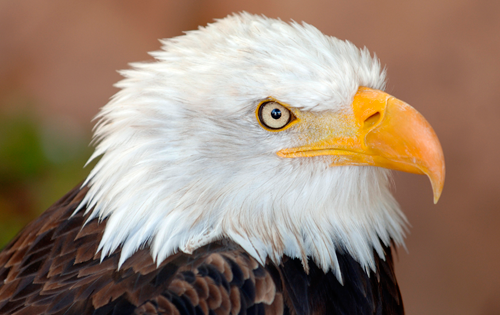BALD EAGLE
Haliaeetus leucocephalus

LENGTH

90 cm
WEIGHT

5.5 kg
LIFESPAN

40 years
The bald eagle, also known as the american eagle, is the only eagle from North America and is the second largest bird on the continent after the California condor.
General characteristics
The wingspan of adult males can reach 2m, while females, which are larger, can reach 2.5m.
Both males and females are of blackish brown color at the back and chest while the head, neck and tail are white. The feet and bill are yellow.
Young eagles are a mixture of brown and white all over the body with a black beak. It takes them about 5 years to have the adult plumage, that is to say, for the head and tail feathers to turn white.
An eagle’s eye is almost as large as a human´s, but its sharpness is at least four times greater than of a person with perfect vision. They are capable of seeing fish in the water from several hundred meters above, while flying.
They can reach a flight speed of about 70km/h and often soar above thermal currents.
Feeding
They can feed on different animals (birds or mammals), but fish comprises the majority of their diet.
Behaviour
They are diurnal animals that generally live alone. They gather only when there is abundant food in a certain place or during nesting periods, when they can form groups of up to 400 individuals.
The eagles’ migratory habits are subject to the seasonality of their supplies; when lakes and streams freeze over, they must go south to find open water or head to the coast.
Their way of hunting is different from other birds: they approach the surface of the water and grab their prey with their talons without going into the water. They are also very opportunistic: when they cannot find food, they may steal it from other animals.
Bald eagles call each other with a high-pitched whistle or chirp similar to the call of a seagull.
Reproduction
Bald eagles maintain the same mate throughout their entire life, except when their mate dies, disappears or is unable to reproduce.
The males perform a spectacular courtship to attract and impress females. From there the pair begin to build the nest from branches that are used for many years and adding new materials each year. For this same reason, the nests of American eagles are larger than any other North American bird, measuring up to 6 m deep, 2.9 m wide and weighing 3 tons.
Females lay 1 to 3 eggs in the nest and the incubation process lasts approximately 38 days. Both parents care for the chicks until they are able to fly freely on their own, which is usually at 18 weeks of age.
Threats
American eagles were classified as an endangered species because of the hunting of these animals for commercial use and pesticides such as DDT being deposited on fish.
With protective regulations in place and the banning of DDT in the United States, the American eagle population is now increasing and is classified as a lower risk species.
Distribution
It is found in North America, covering from northern Mexico to southern Canada and Alaska. They can live in any habitat, but always near bodies of water such as swamps, rivers or lakes.

Did you know?
Eagle bones weigh very little. Feathers weigh almost twice as much as their skeleton.
They can fly up to an altitude of 3000m, which is as high as a commercial airplane.
The white feathers on the head do not appear until it reaches 7 years of age.
Conservation status
